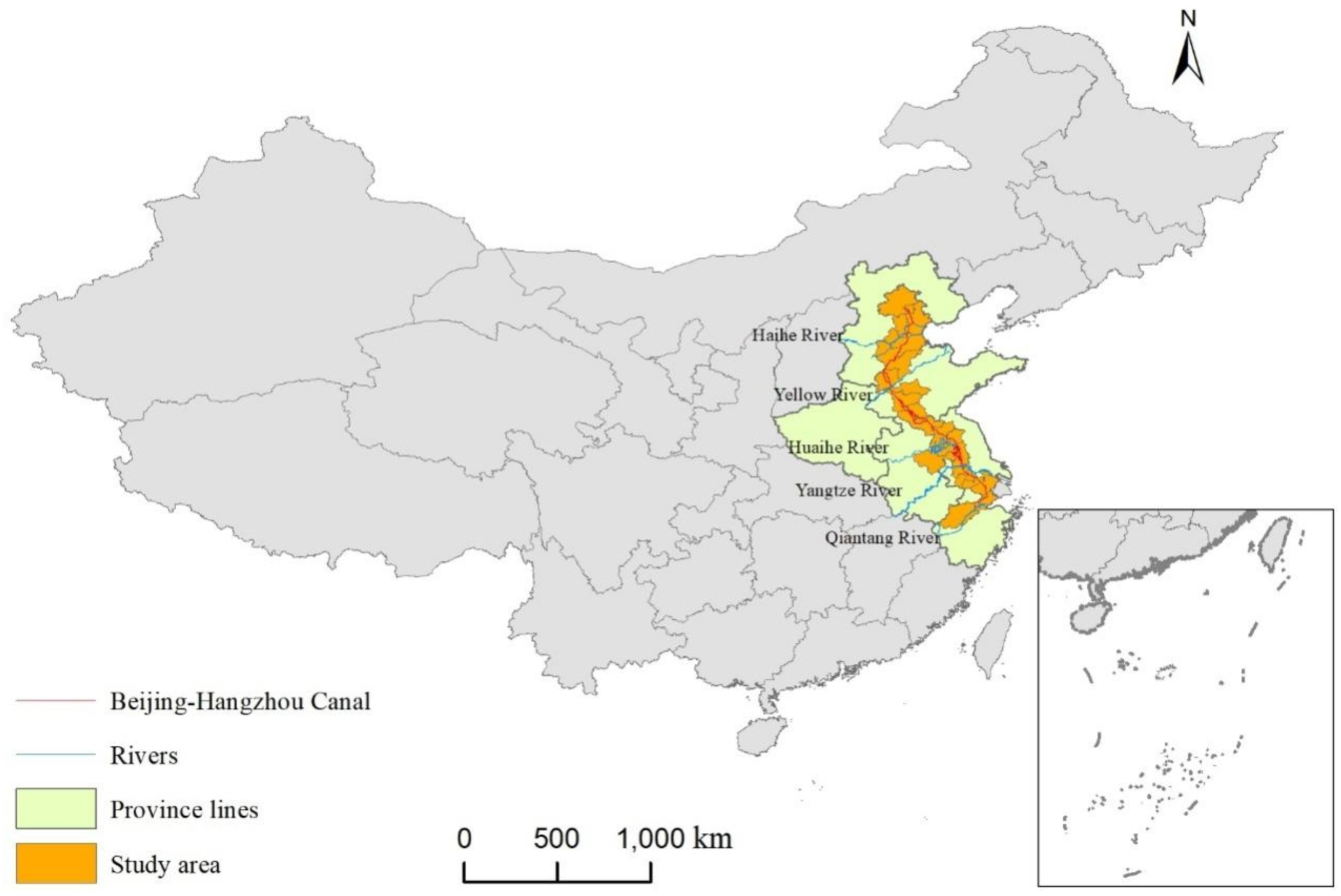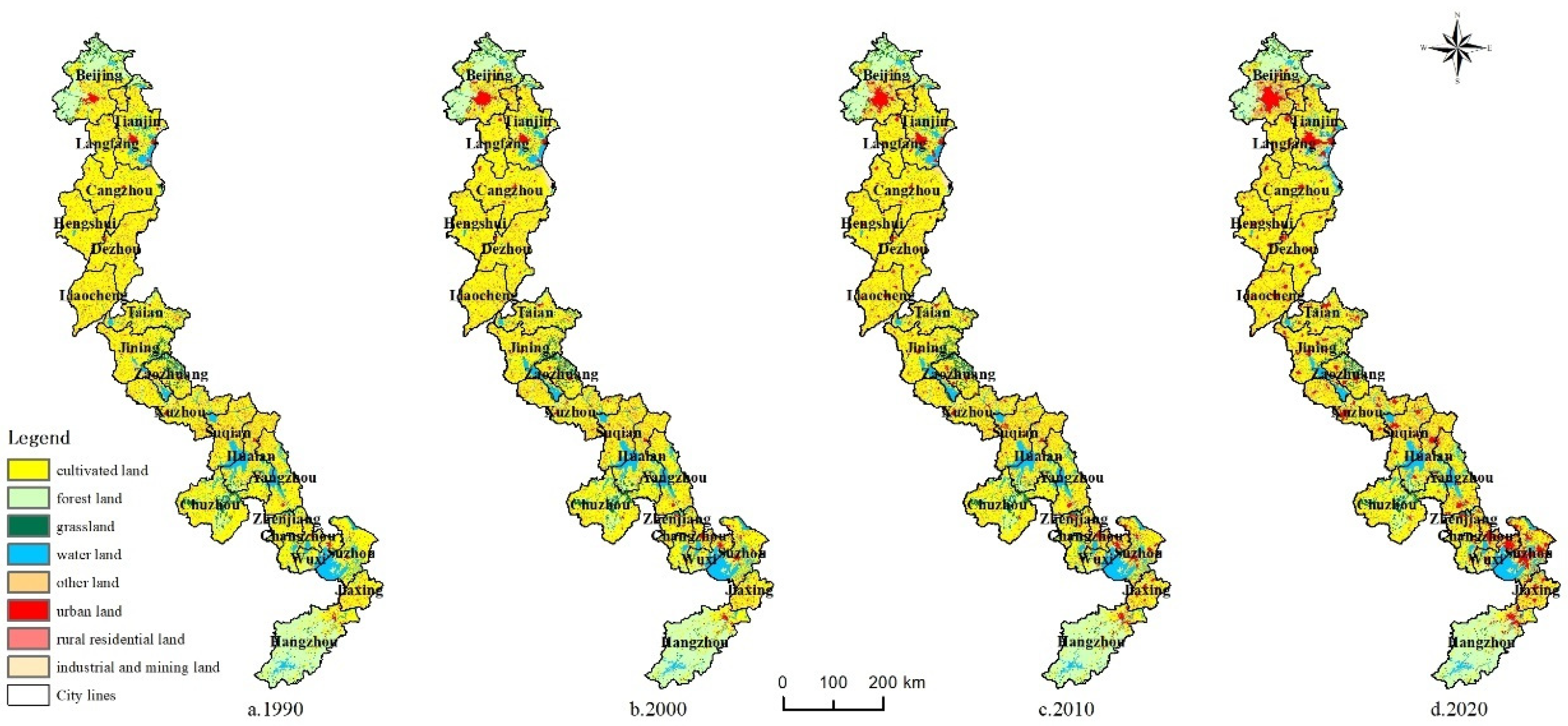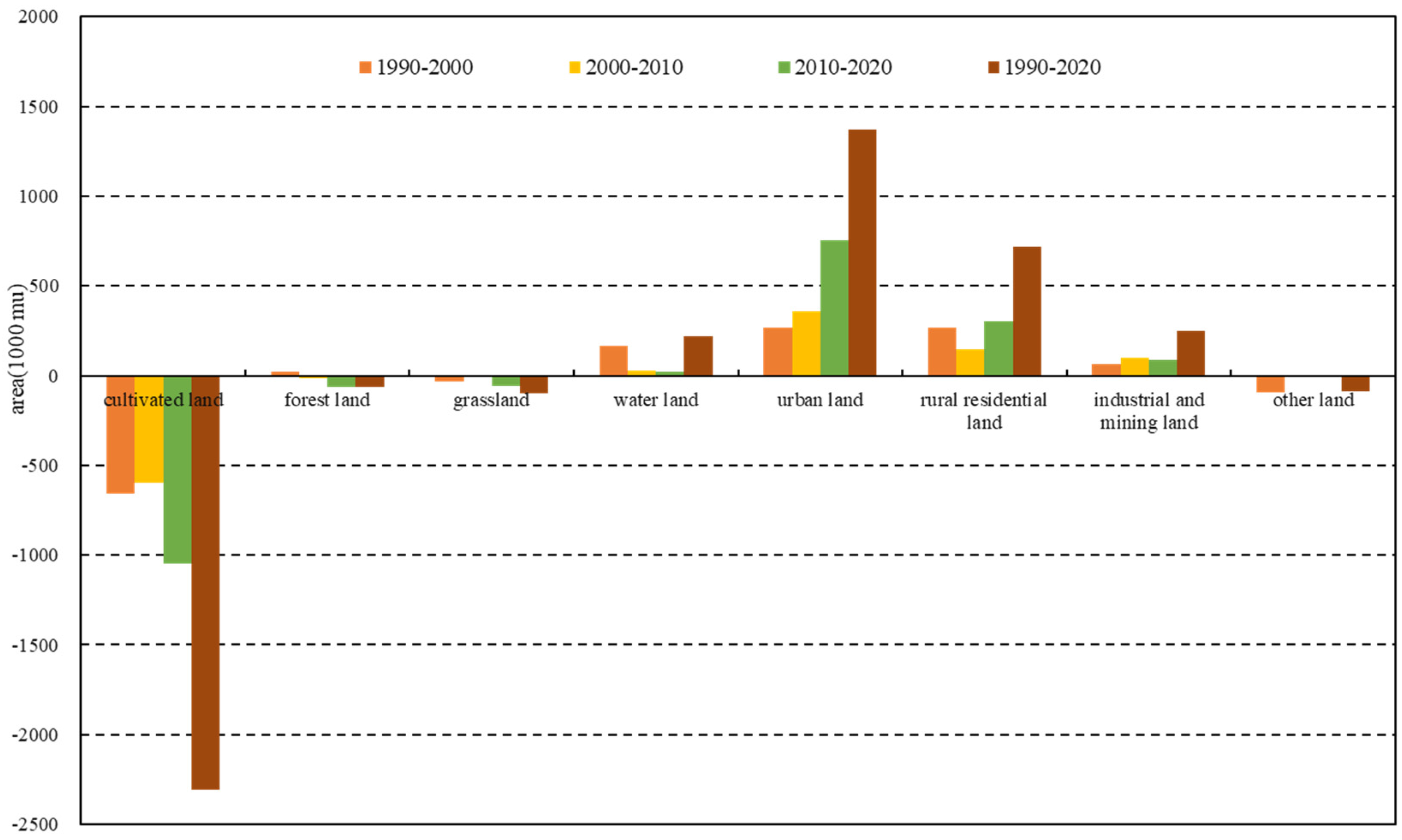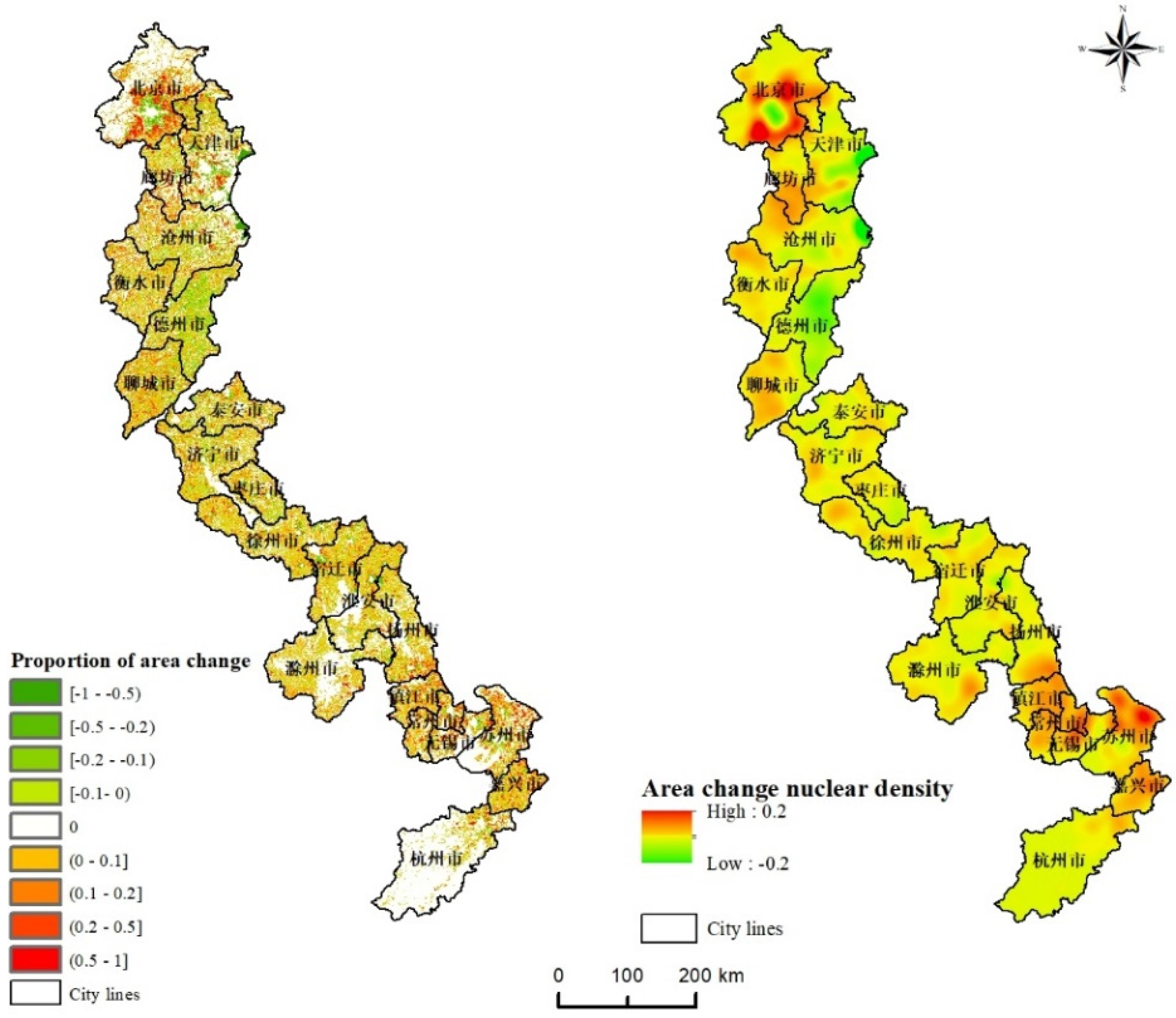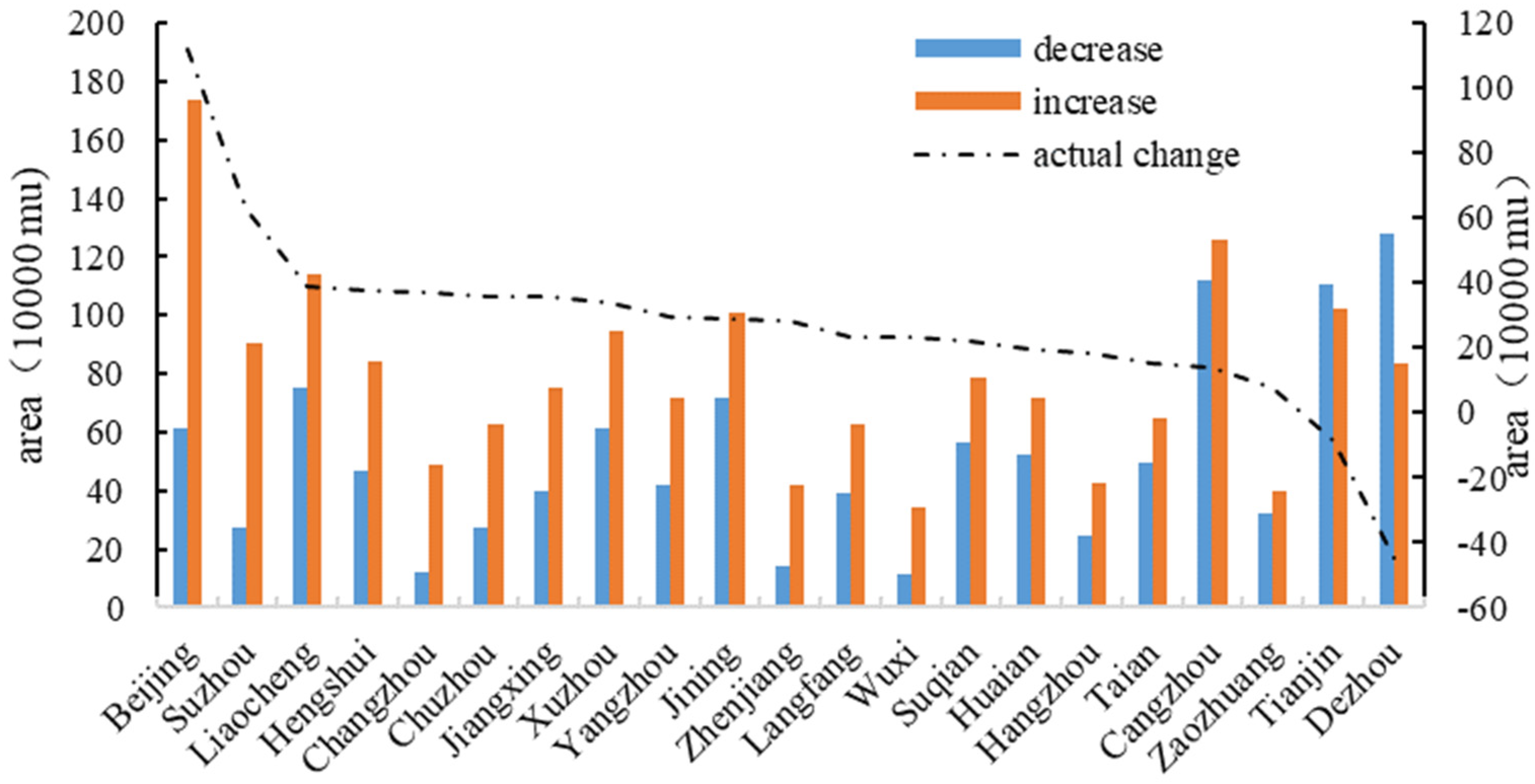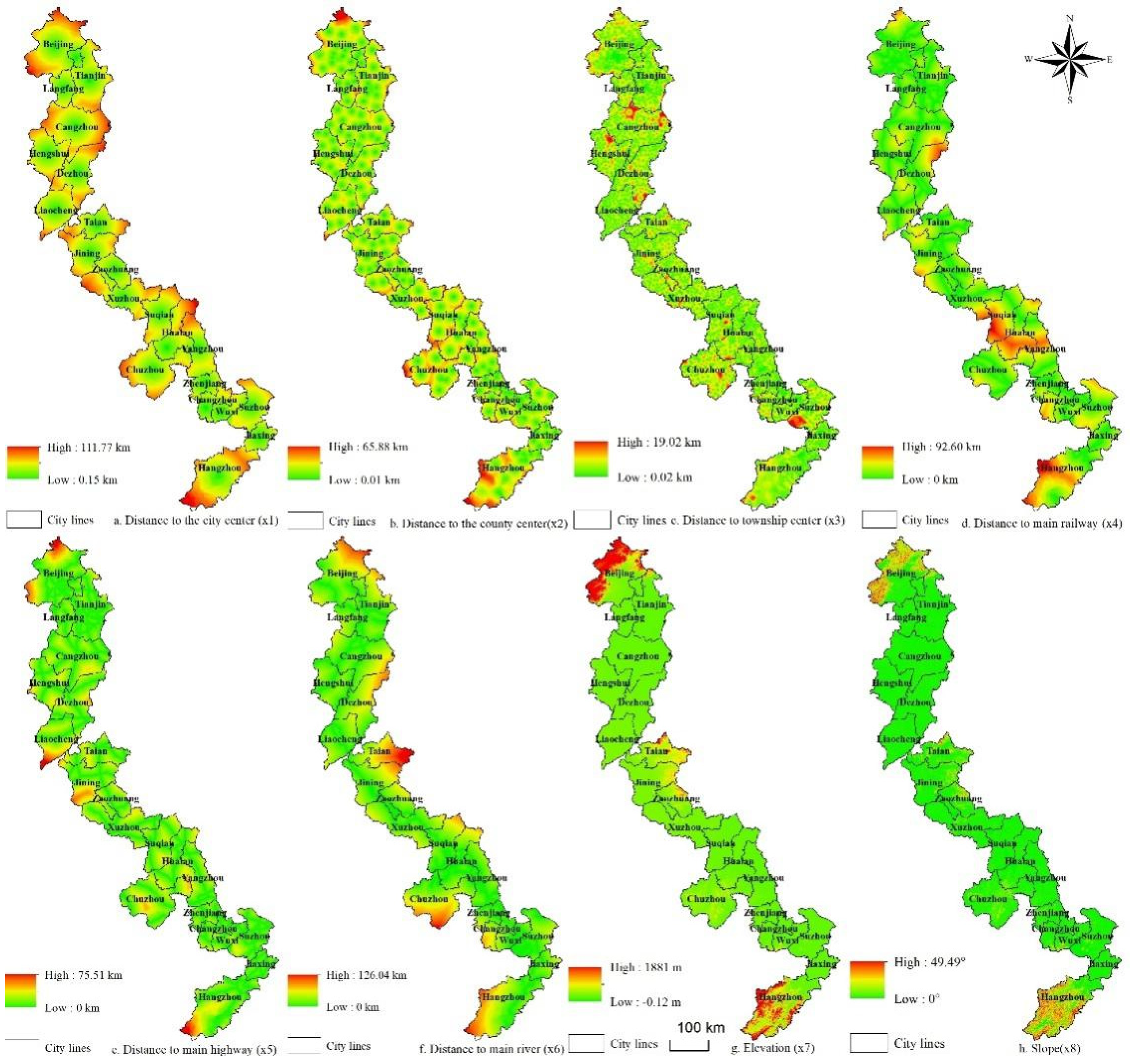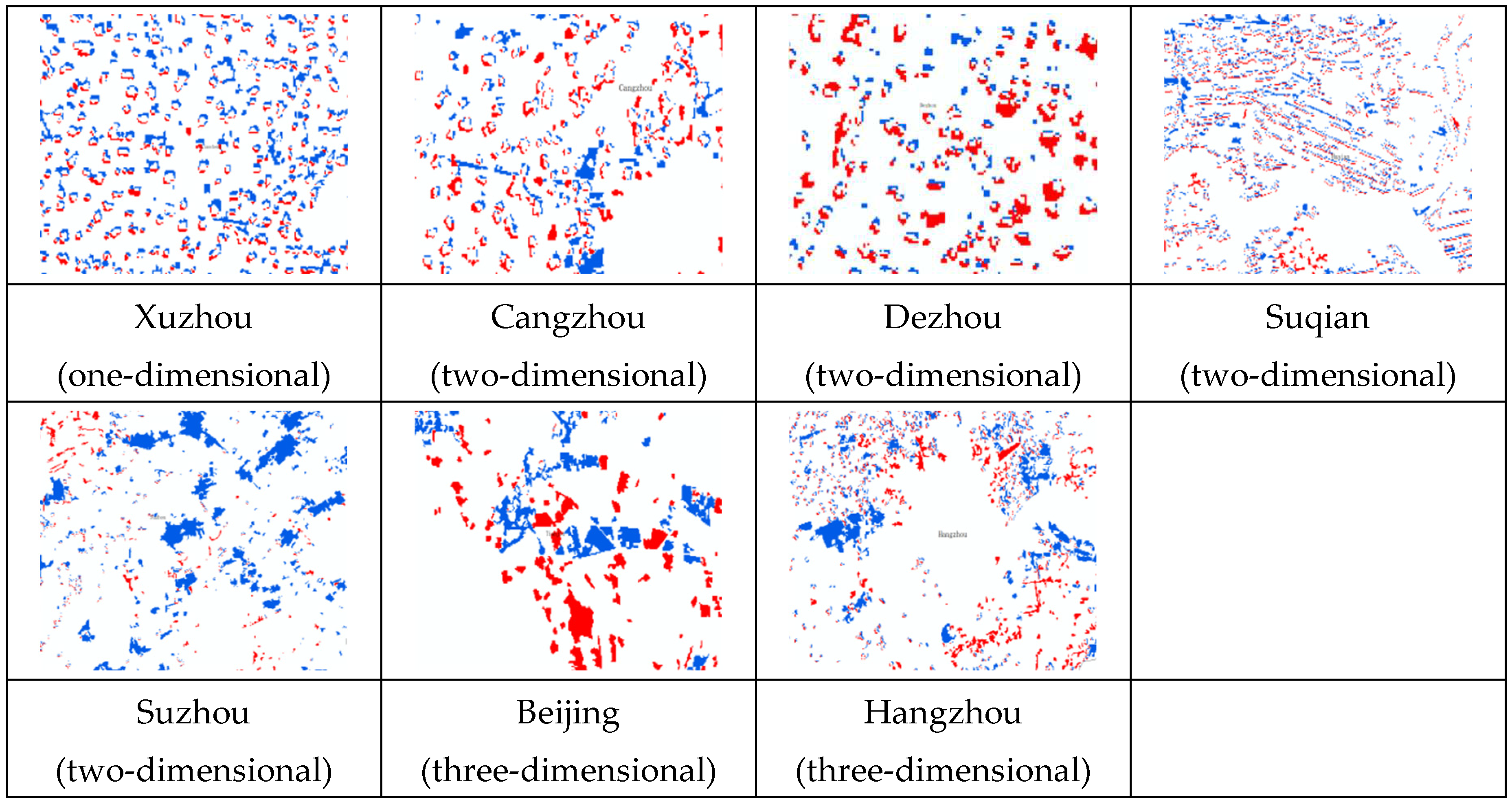1. Introduction
Villages are important rural settlements in which rural residents should live for a long time. They are also the main areas of agricultural production. Due to rapid urbanisation and industrialisation, the population in China has significantly increased and a large number of rural residents moved to urban areas. Nevertheless, the rural population first increased and then decreased. From 1991 to 2022, it decreased from 905 million to 491 million [
1]. With the growing demand for urban land, rural residential areas are being converted to urban construction land, while rural residential land is replaced by agricultural land. In recent years, however, there has been an increase in the number of rural residents migrating to urban areas, resulting in a further increase in the ageing population in the rural areas [
2]. Thus, a large number of rural residential land has been abandoned, resulting in a decrease in land use efficiency [
3,
4]. The introduction of policies such as ‘Merging Villages and Towns’ and ‘New Urbanisation’ has led to the demolition of a large number of rural homesteads [
5,
6], which have been turned into urban construction land or reclaimed as farmland, resulting in significant changes in rural residential land. Nonetheless, the need for rehoming individuals from occupied villages has led to an increase in land use in new rural settlements due to the implementation of adjacent resettlement [
7,
8]. Thus, rural settlements have undergone dynamic changes in time and space, which have had a significant impact on the socioeconomic development of cities. Based on the research on the spatial differentiation and change of rural residential land, it is important to explore the driving factors of rural residential land to improve land use efficiency in spatial planning.
Domestic and international research on rural residential land has reached a mature stage. It includes research on the spatial differentiation and change of rural residential areas [
9,
10], the spatiotemporal relationship between and transformation of rural and urban construction land [
11,
12], and the impact of rural residential areas on social economy [
13]. The methods include remote sensing and spatial analysis technology (ArcGIS), while the research scope involves different villages, towns, counties, cities, provinces, and countries [
14,
15,
16,
17,
18]. The characteristics of rural residential land change vary significantly among different administrative units due to different driving factors. Relying on the research on the driving factors of urban construction land, scholars have divided the driving factors of rural residential land into socioeconomic factors, transportation accessibility factors, and natural environmental factors [
19,
20]. In particular, the level of socioeconomic development has affected the size of rural residential land, especially in the economically developed eastern coastal areas where the growth rate of rural residential land is much higher than that in the western regions [
21]. The rapid expansion of rural residential land near the city is more prominent than that in remote mountainous areas. Transportation accessibility mainly includes railways, motorways, and major rivers. These transportation arteries provide conveniences for farmers, especially for the development of agricultural production. Thus, most rural residential areas have a linear distribution that relies on main transportation arteries and rivers [
22]. Natural environmental factors affect the distribution of rural residential land. This is why areas with flat terrain and relatively low elevation should become rural residential areas and not those with frequent earthquakes, volcanic eruptions, and mudslides. Thus, the density of rural residential land in the plains is much higher than that on plateaus and mountains [
23]. The density of rural residential areas and their land use changes are influenced by various driving factors. Methods to analyse the driving factors of rural residential land include regression analysis, which detects the temporal factors of change in rural residential land, and geographic weighted regression and geographic detectors, which detect the spatial factors of the change in rural residential land [
24,
25]. The research data of rural residential areas constitute spatial vector points and land grid data. To systematically analyse the spatial differentiation of the rural residential land, the rural residential land in different administrative units is converted to grid data with uniform resolution by means of kernel density analysis or grid scale conversion. In particular, the GIS spatial analysis method provides reliable technical support for the spatiotemporal analysis of rural residential land [
26,
27].
As the number of emptied and abandoned rural homestead rises, the Chinese government began to strictly supervise rural homesteads. The newly revised ‘Land Management Law of the People’s Republic of China’ in 2022 stipulates that rural villagers can own one homestead per household and that the villagers should use the abandoned homestead and land in the village for residential construction. This also indicates that most county and district governments will no longer approve the addition of new rural homesteads. Thus, it is important to understand the size and dynamic transformation of abandoned rural homesteads and analyse the spatiotemporal changes of rural residential land and its relationship with different factors to optimise the rural residential land layout.
The Grand Canal in China is an important watershed that connects the northern and southern regions through five major river systems. The cities along the Canal are economically and socially developed, with high population density and a developed transportation network. Likewise, it is an important research area because the land use of rural residential areas on the Canal has changed significantly. The purpose of this study is to explore the driving factors that affect the rural residential land. It analyses the spatial and temporal changes of rural residential land in 21 cities along the Grand Canal, as well as the natural environment and policies of these cities. To conduct the analysis, the study used spatial remote sensing data from 1990 to 2020. Furthermore, it used a point-axis-region three-dimensional (3D) driving factor system to detect the driving factors of rural residential land in different cities. This paper is of great significance to the exploration of the relationship between rural population change and land use change. It also offers insight into the necessary means for planning and intensively and economically utilising rural residential land in the city.
3. Results
3.1. The characteristics of overall changes in land use
The land use types of the Grand Canal mainly include agricultural land, forest land, rural residential land, water area land, grassland, and urban construction land. In 1990, the area proportions of the six land use types were 64.6%, 12.6%, 8.8%, 8.0%, 3.1%, and 1.7%, respectively. In 2020, however, the area proportions of the six land use types were 56.6%, 12.4%, 11.3%, 8.8%, 2.8%, and 6.5%, respectively. Agricultural land, urban construction land, and rural residential land were evenly distributed. In the north, the main expansion areas of urban construction land were Beijing and Tianjin, while in the south, they were Suzhou and Wuxi. The water area land was found in Tianjin, Huai’an, Yangzhou, and Suzhou, while forest land was found in Beijing, Jining, Zaozhuang, Chuzhou, and Hangzhou.
Figure 2.
The spatial distribution of land use types in the Grand Canal (1990-2020).
Figure 2.
The spatial distribution of land use types in the Grand Canal (1990-2020).
From 1990 to 2000, agricultural land, grassland, and other land decreased by 6.553 million mu, 353,000 mu, and 909,000 mu, respectively. Forest land, water area land, urban construction land, industrial and mining land, and rural residential land increased by 208,000 mu, 1.672 million mu, 2.663 million mu, 642,000 mu, and 2.649 million mu, respectively. At this stage, agricultural land and unused land were converted to water area land, urban construction land, and rural residential land. From 2000 to 2010, agricultural land, forest land, grassland, and other land decreased by 5.998 million mu, 170,000 mu, 110,000 mu, and 31,000 mu, respectively. In contrast, water area land, urban construction land, industrial and mining land, and rural residential land increased by 259,000 mu, 3.549 million mu, 1.009 million mu, and 1.492 million mu, respectively. This stage was characterized by the conversion of agricultural land to urban land and industrial and mining land. From 2010 to 2020, agricultural land, forest land, and grassland decreased by 10.502 million mu, 636,000 mu, and 544,000 mu, respectively, while water area land, urban construction land, industrial and mining land, and rural residential land increased by 232,000 mu, 7.51 million mu, 883,000 mu, and 3,011,000 mu, respectively. At this stage, agricultural land, forest land, and grassland were converted to urban industrial and mining land. From 1990 to 2020, the main areas that experienced significant changes were agricultural land, urban construction land, and rural residential land. In particular, agricultural land decreased by 23.053 million mu, accounting for 8.1% of the area. Urban construction land increased by 13.722 million mu, accounting for 4.8% of the area, while rural residential land increased by 5.6981 million mu, accounting for 2.5% of the area. It can be seen that the reduced agricultural land, forest land, and grassland on the Grand Canal was converted to urban construction land, rural residential land, or industrial and mining land.
Figure 3.
Changes in land use types and their area size on the Grand Canal during different periods.
Figure 3.
Changes in land use types and their area size on the Grand Canal during different periods.
3.2. Characteristics of changes in rural residential land
From 1990 to 2020, the distribution of changes in rural residential land was relatively uniform, mainly concentrated in villages around the central urban areas of the cities on the Grand Canal. As time passed and new policies were introduced, there had been significant changes in the spatial layout of rural residential land, with some villages experiencing a decrease or an increase in area size. Within the 1 km ×1 km grid range, the proportion of changes in rural residential land in most cities ranged from -10% to 10%. Based on the spatial distribution of rural residential land, it was found that the extremely dense rural residential land in northern cities was mainly concentrated around Beijing, where rural residential land increased over 50%. The areas with significantly sparse rural residential land were mainly distributed in Tianjin and Dezhou, where rural residential land decreased over 50%. The significant increase in rural residential land in southern cities was mainly found in Suzhou, Wuxi, Changzhou, etc. The proportion of changes in rural residential land was between 20-50%.
Figure 4.
The change in density of rural residential land (1990-2020).
Figure 4.
The change in density of rural residential land (1990-2020).
According to the changes in rural residential land area on the Grand Canal from 1990 to 2020, the total area increased by 16.6521 million mu and decreased by 10.954 million mu, resulting in an actual increase of 5.6981 million mu. Cities that have added over 1 million mu include Beijing, Cangzhou, Liaocheng, Tianjin, and Jining. Cities with an area of less than 500,000 mu include Changzhou, Hangzhou, Zhenjiang, Zaozhuang, and Wuxi. In contrast, cities with a decrease in rural residential land area of over 1 million mu include Dezhou, Cangzhou, and Tianjin, while cities with less than 300,000 mu include Chuzhou, Suzhou, Hangzhou, Zhenjiang, Changzhou, and Wuxi. Thus, it was found that the spatial changes of rural residential land in the northern cities of the Grand Canal were significant, while those in the southern cities were relatively small.
Based on the actual changes in rural residential land, it was found that only Beijing’s rural residential land increased by over 1 million mu, followed by Suzhou, with a rural residential land area of 629,000 mu. The size of rural residential land in Dezhou and Tianjin significantly decreased, with 449,500 mu and 85,100 mu, respectively. The change in size of rural residential land in 12 cities ranges from 200000 to 400000 mu, while that in Huai’an, Tai’an, Hangzhou, Cangzhou, and Zaozhuang was less than 200,000 mu. Cities with per capita rural residential land exceeding 5 mu include Chuzhou, Yangzhou, Zhenjiang, and Hangzhou. However, cities with less than 2 mu include Liaocheng, Langfang, Zaozhuang, and Jiaxing. Due to the impact of the rural population in different regions, the per capita rural residential land area in each region varied to some extent. For example, the per capita rural residential land area in the southern region of the Grand Canal was higher than that in the northern region. Thus, it can be inferred that Beijing and Suzhou, as the central cities of the northern and southern regions, respectively, had significantly higher levels of socioeconomic development and urbanisation compared to other regions. This had a strong effect on the changes in the size of rural residential land. However, as the main cities in Shandong Province began implementing the ‘Merging Villages and Towns’ policy, Dezhou significantly reduced the size of rural residential land.
Figure 5.
The change in area size of rural residential land on the Grand Canal (1990-2020).
Figure 5.
The change in area size of rural residential land on the Grand Canal (1990-2020).
3.3. Driving factors of rural residential land
According to the distribution characteristics of the driving factors that influence the spatial differentiation of rural residential land, it was found that the distance to the market location, such as city centres, county centres, and town centres, was distributed in a clear concentric circle. The maximum distance to city or county centres was distributed in the peripheral areas of the Grand Canal, while the maximum distance to town centres was distributed around cities, such as Cangzhou, Hengshui, and Suzhou. Furthermore, the spatial distribution of the distance to major motorways, railways, and rivers was zonal. The maximum distance to major railways was distributed in a line, from Suqian, then to Huai’an, and finally to Yangzhou. The maximum distance to major motorways was found west of Liaocheng, while the maximum distance to rivers was located east of Tai’an. Lastly, the distribution of the factors of the natural environment, such as elevation and slope, were similar, with their maximum values distributed in the northern and southern peripheral areas of the study area.
Figure 6.
The distribution of driving factors that influence the spatial differentiation of rural residential land on the Grand Canal.
Figure 6.
The distribution of driving factors that influence the spatial differentiation of rural residential land on the Grand Canal.
Using geographic detectors, this study found that all 21 cities were influenced by socioeconomic driving factors. Except for Xuzhou City, 20 cities were affected by the driving factors of transportation accessibility. Only five cities, including Beijing, Tai’an, Zaozhuang, Zhenjiang, and Hangzhou, were affected by the driving factors of the natural environment. The distance to the city centre had the greatest impact on the differentiation of rural residential land, with 20 cities being affected and an average decision-making power of 2.9. Next is the distance to the main rivers, which affected 19 cities with an average decision-making power of 1.9. The impact of elevation and slope was minimal. Elevation affected 4 cities, while slope affected 3 cities, with an average decision-making power of only 0.3 and 0.29, respectively.
To further explore the differentiation types of rural residential land in 21 cities, the study divided all cities into three categories based on the dimensions of the driving factors. Xuzhou, the only one-dimensional city, was influenced by the distance to the city and county centre. Thus, it represents a point-driven development city. Next, two-dimensional cities, including 15 cities, among which are Tianjin, Langfang, and Cangzhou, were influenced by the distance to the city, county, or town centre and the distance to the main railways, motorways, or rivers. These cities represent the main types of rural residential land, which can be termed point-axis-driven development cities. Finally, three-dimensional cities, including Beijing, Tai’an, Zaozhuang, Zhenjiang, and Hangzhou, were driven by a combination of socioeconomic factors, transportation accessibility, and the natural environment. These cities represent the ‘point-axis-region-driven development cities.’
Table 3.
Results of driving factor detection for rural residential land on the Grand Canal.
Table 3.
Results of driving factor detection for rural residential land on the Grand Canal.
| City |
X1 |
X2 |
X3 |
X4 |
X5 |
X6 |
X7 |
X8 |
Driver dimension |
| Beijing |
2.03 |
0.34 |
0.52 |
0.51 |
0.42 |
1.33 |
0.97 |
0.90 |
three-dimensional |
| Tianjin |
3.34 |
5.31 |
1.56 |
0.58 |
0.54 |
1.99 |
0.34 |
0.13 |
two-dimensional |
| Langfang |
1.47 |
1.21 |
0.21 |
0.22 |
0.29 |
2.68 |
0.12 |
0.24 |
two-dimensional |
| Cangzhou |
19.12 |
9.94 |
0.77 |
0.79 |
0.65 |
4.40 |
0.13 |
0.00 |
two-dimensional |
| Hengshui |
1.19 |
0.16 |
0.65 |
0.15 |
0.07 |
0.75 |
0.00 |
0.00 |
two-dimensional |
| Dezhou |
4.16 |
0.25 |
0.51 |
1.34 |
0.72 |
3.15 |
0.00 |
0.00 |
two-dimensional |
| Liaocheng |
1.69 |
1.12 |
0.35 |
1.23 |
0.99 |
1.14 |
0.00 |
0.00 |
two-dimensional |
| Tai’an |
1.11 |
0.40 |
0.29 |
1.20 |
0.70 |
2.98 |
1.33 |
0.11 |
three-dimensional |
| Jining |
0.97 |
0.60 |
0.40 |
0.20 |
0.55 |
0.37 |
0.09 |
0.06 |
two-dimensional |
| Zaozhuang |
1.83 |
3.12 |
0.52 |
1.26 |
0.18 |
1.12 |
0.77 |
0.08 |
three-dimensional |
| Xuzhou |
0.73 |
0.60 |
0.30 |
0.40 |
0.29 |
0.29 |
0.02 |
0.11 |
one-dimensional |
| Suqian |
0.48 |
0.80 |
0.22 |
1.87 |
0.06 |
1.12 |
0.00 |
0.24 |
two-dimensional |
| Huai’an |
0.89 |
0.37 |
0.30 |
2.43 |
1.71 |
0.99 |
0.00 |
0.01 |
two-dimensional |
| Chuzhou |
1.89 |
0.55 |
0.79 |
2.13 |
2.53 |
5.66 |
0.06 |
0.10 |
two-dimensional |
| Yangzhou |
3.00 |
0.40 |
0.05 |
1.28 |
0.31 |
0.80 |
0.09 |
0.00 |
two-dimensional |
| Zhenjiang |
1.63 |
1.27 |
1.34 |
0.25 |
0.72 |
1.76 |
0.42 |
1.40 |
three-dimensional |
| Changzhou |
3.67 |
1.06 |
1.16 |
1.58 |
1.21 |
2.30 |
0.27 |
0.33 |
two-dimensional |
| Wuxi |
4.54 |
3.25 |
1.52 |
0.65 |
0.38 |
1.70 |
0.30 |
0.30 |
two-dimensional |
| Suzhou |
3.93 |
0.50 |
0.25 |
1.41 |
0.73 |
2.09 |
0.07 |
0.24 |
two-dimensional |
| Jiaxing |
1.60 |
0.18 |
0.80 |
0.57 |
0.18 |
3.14 |
0.07 |
0.28 |
two-dimensional |
| Hangzhou |
1.78 |
1.32 |
0.57 |
1.46 |
0.39 |
1.19 |
1.32 |
1.62 |
three-dimensional |
5. Conclusions
Due to urbanisation, the rural population has migrated to urban areas, resulting in a decrease in the efficiency of rural residential land use and an increase in the number of abandoned rural homesteads. In the context of integrating urban and rural areas and protecting farmlands, one key issue requires immediate attention. This issue deals with the scientific analysis of the remaining rural residential land to ensure the improvement of its land use efficiency. This study observed 21 cities on the Grand Canal and analysed the spatiotemporal differentiation of their rural residential land under various driving factors using geographic detectors. It offered suggestions for scientific planning of rural residential land according to local conditions and provided reference for the conservation and intensive use of that land. This study drew the following conclusions.
(1) The cities with a significant increase in rural residential land (over 1 million mu) in the Grand Canal were concentrated in the north, including Beijing, Tianjin, Cangzhou, etc. The cities with a smaller decrease (less than 300,000 mu) were mainly concentrated in the south, including Suzhou, Hangzhou, Zhenjiang, etc. It was found that the changes in rural residential land in the northern cities were significant. In contrast, the changes in rural residential land in the southern cities were relatively stable. The main sources of increase in the rural residential land include agricultural land and forest land, while the main sources of decrease include urban industrial and mining land and agricultural land. From 1990 to 2020, rural residential land experienced a cycle of changes in agricultural land, rural residential land, and urban construction land.
(2) The driving factors that affected the spatiotemporal differentiation of rural residential land were mainly manifested as socioeconomic factors (points), transportation accessibility (axes), and the natural environment (regions). According to the number of driving factors and their decision-making power (greater than 0.5), the 21 cities were divided into three types: one-dimensional, two-dimensional, and three-dimensional cities. The one-dimensional city, Xuzhou, was mainly influenced by socioeconomic factors. In this city, significant differences in the change of rural residential land could be spotted around urban centres. Moreover, the two-dimensional cities were mainly influenced by socioeconomic factors and factors of transportation accessibility. This city type included 15 cities, such as Tianjin, Langfang, and Yangzhou. In these cities, rural residential land was found in circular and linear patterns around the urban centre and main transportation arteries. Finally, the three-dimensional cities were influenced by all driving factors. This city type included five cities, such as Beijing, Hangzhou, and Tai’an. Apart from the rural residential land exhibiting a linear and circular pattern, the distribution of rural residential land in these cities was relatively scattered due to the rugged terrain.
(3) Based on the spatial differentiation characteristics and driving factors of rural residential land, this study proposed three types of villages to ensure the intensive use and careful planning of rural residential land and the protection of agricultural land, and improve the efficiency of rural residential land use. These villages would be developed based on the following strategies: the construction of large-scale villages through relocation and consolidation, the construction of new villages through relocation and reconstruction, and the construction of advanced villages through intensive expansion and contraction. The relocation and consolidation of rural areas implies using old residential areas as the central village, merging multiple scattered villages in the surrounding area, and freeing up excess rural residential land and transforming it into agricultural land. Relocation and reconstruction-oriented rural areas imply building new villages in other suitable locations, relocating multiple existing villages, and constructing new larger villages. The original rural residential land would be converted to farmland, forests, or grasslands. These areas would then focus on ecological restoration. Intensive expansion and contraction of rural areas implies that they retain the original villages, improve the level of rural housing through renovation, move scattered rural homesteads to central villages through spatial replacement, transform the remaining rural homesteads into collective assets, and build commercial housing or shop houses to increase the collective economic income.
